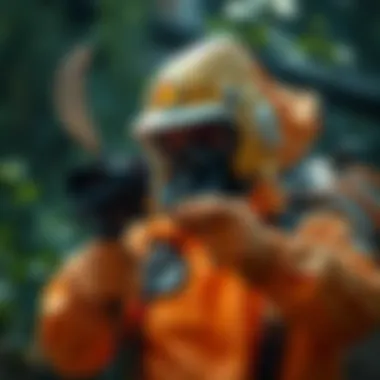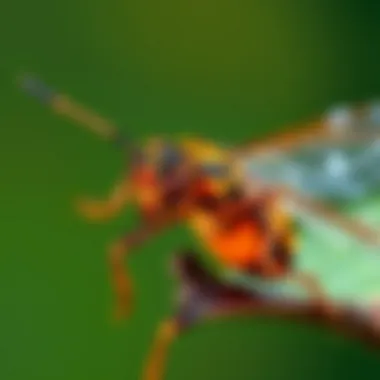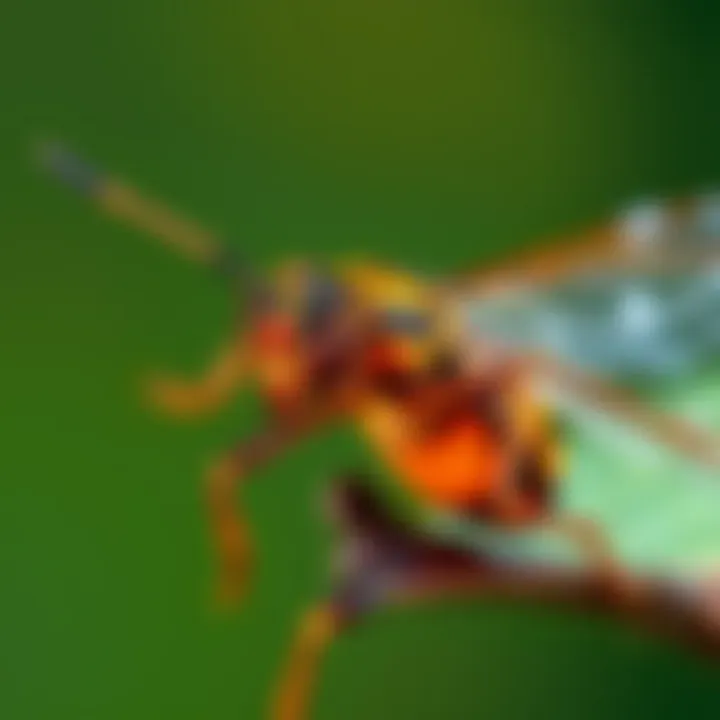Edge Bug Control: Strategies for Sustainable Pest Management


Intro
In the realm of pest management, the approach one takes can significantly influence not just the effectiveness of the control efforts, but also the surrounding environment. This is where the concept of edge bug control comes into play. It goes beyond mere extermination of pests, focusing instead on a more sophisticated understanding of their behaviors, the tissues of ecosystems they inhabit, and solutions that dovetail with environmental principles. Homeowners and housewives alike should explore the nuances of edge bug control to cultivate a harmonious balance between living spaces and nature.
Let's delve into understanding how pests operate and the groundbreaking, eco-friendly solutions available today. By the end of this exploration, one should recognize that frustration with pests may transform into informed, effective management strategies that honor both home and earth.
Understanding Pests
Definition of Pests
Pests are typically described as organisms that cause harm or nuisance to humans, their property, or their resources. This includes insects, rodents, and even some plants that invade garden spaces. However, it is essential to recognize that what constitutes a pest can vary based on circumstances and perspective. For instance, while a ladybug is usually charming in the garden, it can be less so if it invades your living room. It’s a matter of context.
Importance of Pest Identification
Understanding what pests you’re dealing with is crucial. Not all bugs are born equal, and identifying the specific type of pest can aid in selecting the appropriate control method. For example, knowing whether you have aphids or thrips can drastically change the course of your battle plan.
A few tips for identification include:
- Observing the environment: Where pests are found often hints at their origins.
- Assessing damage: Different pests leave distinct marks on plants or property.
- Utilizing technology: There are apps that can help identify common household pests just by taking a picture.
Prevention Techniques
Home and Garden Preventative Measures
An ounce of prevention is worth a pound of cure. Simple adjustments in your home and garden can minimize the chances of pest invasions. Consider the following strategies:
- Seal entry points: Inspect windows, doors, and vents to ensure no gaps are left for pests to slide through.
- Maintain cleanliness: A tidy environment can make it tough for pests to settle. Regularly clear away debris, and ensure food is stored in airtight containers.
Seasonal Prevention Tips
Each season brings its own set of challenges when it comes to pests. Being vigilant ahead of the season can save you a great deal of hassle. For instance:
- Spring: Inspect plants for early blooms of aphids and treat them with a diluted soap spray.
- Summer: Wet conditions might invite mosquitoes. Consider installing screens in windows or using fans outdoors to thwart their presence.
Eco-Friendly Pest Control Solutions
Overview of Sustainable Practices
In recent years, eco-friendly pest control methods have gained traction, emphasizing sustainability while managing the inconvenience pests bring. Approaches include:
- Integrated Pest Management (IPM): This strategy uses a combination of methods that maintain pest populations at acceptable levels without harming the environment.
- Mechanical controls: Traps or barriers can be efficient ways to manage invasive species without chemicals.
Natural Remedies and Their Effectiveness
For those looking for solutions right from the pantry, there are plenty of natural remedies touted for pest control. Some of them include:
- Diatomaceous earth: A powdery substance that can effectively deter crawling insects.
- Essential oils: Oils like peppermint and tea tree can be natural repellents, providing a dual benefit of pleasant aromas.
"Sustainable pest management is not merely an option anymore; it's a necessity for harmonious living with our environment."
In closing, understanding edge bug control is crucial for both emotional relief from pest-related tension and achieving environmental harmony in one’s living quarters. This guide serves as a launching pad for those ready to embrace both innovative strategies and eco-friendly practices.
Prelims to Edge Bug Control
Understanding edge bug control is pivotal for homeowners and those engaged in the management of pests in various environments. Every nook and cranny in our living spaces can become a breeding ground for pests, and knowing how to control these infestations can be a game changer. By diving deep into edge bug control, we not only aim to safeguard our surroundings but also maintain the delicate balance of the ecosystem.
The Importance of Taming Pests
Pests like ants, cockroaches, and mosquitoes can wreak havoc if left unchecked. Picture this: an unexpected swarm of ants marching across your kitchen counter, or a lone cockroach making an uninvited appearance during dinner. These scenarios are not just unpleasant; they can lead to significant health risks and property damage.
Effective edge bug control strategies empower homeowners to manage and prevent such infestations efficiently and effectively. With the right knowledge and tools, one can take proactive measures to keep pests at bay, ensuring a safe and pleasant living environment.
Benefits of Understanding Edge Bug Control
- Environmental Awareness: Recognizing the role pests play in the ecosystem can lead to a more thoughtful approach in pest management, avoiding harmful methods that disrupt nature's balance.
- Cost Savings: By preventing pest issues before they become serious, homeowners can save significantly on costly treatments and repairs.
- Improved Quality of Life: A pest-free home is not just about avoiding bugs; it’s about peace of mind. Knowing that your home is safe creates a more enjoyable living environment.
Key Considerations
While edge bug control may seem straightforward, there are several critical factors to consider:
- Identify the Pests: Understanding what kind of pests you’re dealing with is half the battle. Different insects require different approaches.
- Choose Your Methods Wisely: There are numerous pest control methods available, from chemical solutions to more eco-friendly alternatives. A well-rounded knowledge of these can help in making informed choices.
- Monitor and Adapt: Pest control isn’t a one-and-done deal. Continuous monitoring and adjustments based on observed pest behavior are essential.
"Knowledge is power, especially when dealing with edge pests. A little understanding goes a long way."


Venturing into the world of edge bug control not only prepares individuals to tackle infestations but fosters a sense of empowerment as they become guardians of their own home. The journey of pest management is intricate but crucial, and as we navigate through advanced strategies in this article, homeowners will find themselves equipped to make informed decisions for both their well-being and the environment.
Understanding the Concept of Edge Bug Control
When delving into the world of pest management, understanding the concept of edge bug control is crucial. This approach highlights the intricate balance needed to manage pests effectively while being mindful of environmental impacts. It advocates for thinking beyond just extermination; rather, it promotes understanding insect behavior and their roles within ecosystems.
Definition and Scope
At its core, edge bug control refers to specialized strategies aimed at managing pests that inhabit boundary areas, such as gardens, lawns, and agricultural edges. These zones are often rich in biodiversity, making them critical environments for both pest populations and beneficial organisms. So, the definition unfolds through a dual lens:
- Pest Management: Involves strategies that minimize pest damage to crops and gardens.
- Ecological Awareness: Emphasizes maintaining the ecological balance, including the protection of beneficial insects.
This is where the scope of edge bug control widens. It incorporates techniques like habitat management, altering physical structures, and using eco-friendly pest control substances. The aim is to foster an environment where beneficial insects thrive while effectively managing harmful ones. This approach encourages the embrace of various methods—from cultural practices, like crop rotation, to the intelligent selection of native plants that attract natural predators of pests.
Historical Evolution of Pest Management
The journey of pest management spans centuries, evolving in response to both agricultural needs and societal awareness of environmental impacts. Historically, pest control was largely reactive; farmers would apply methods that were effective but often detrimental to the ecosystem. These included the widespread use of synthetic pesticides that, while successful for immediate pest control, led to longer-term ecological issues, such as soil degradation and resistance development.
The late 20th century marked a pivotal shift. Interest in integrated pest management (IPM) surged, prompting a more holistic view of pest control. During this era, researchers began understanding the complexities of pest ecosystems, acknowledging that pests are part of a larger biological web. Efforts commenced towards combining traditional practices with modern techniques, steering away from over-reliance on chemicals. This informed today’s edge bug control strategies, blending ancient agricultural knowledge with the latest technological advancements, such as drone surveillance and data analytics.
Understanding the evolution of pest management highlights the progress made and the ongoing journey towards sustainable practices.
As we look back, it’s clear that the framework of edge bug control not only addresses current pest challenges but also gees up for future trends that embrace sustainability and ecological integrity. The ongoing quest for knowledge and innovation keeps the field dynamic, with new insights continually shaping best practices.
Common Insects and Pests
Understanding common insects and pests is paramount for effective edge bug control. This knowledge is not just for the sake of convenience; it serves as the bedrock of smart pest management strategies that save time, frustration and resources for both homeowners and garden enthusiasts. Recognizing specific pests and their roles in the environment allows us to address infestations in a more targeted manner, which can lead to sustainable solutions instead of haphazard approaches that often exacerbate the issue.
Identifying Key Pests
When it comes to pest management, being able to identify key pests is half the battle won. Homeowners may find themselves dealing with various pests like the common ant, the elusive cockroach, or the persistent spider mites. Each of these insects has distinct behaviors and triggers, making their recognition vital for mitigative actions.
- Ants: These little critters march to their own beat, often invading kitchens in search of food. Identifying which species is crucial, as not all ants are created equal; some are simply looking for crumbs, while others can establish colonies within your walls.
- Cockroaches: They’re not just creepy crawlers; they can carry diseases. A few telltale signs, like droppings or a musty odor, can alert you to their presence. Knowing when and how to act can prevent a minor nuisance from turning into a full-blown infestation.
- Spider Mites: These tiny pests can weaken plants pretty quickly, leading to yellowing leaves and stunted growth. Spotting the fine webs or pinprick holes in leaves is key to catching them early.
Assessing Their Impact on Ecosystems
Pests aren't merely nuisances; they play complex roles within ecosystems. Understanding this interplay gives homeowners a more nuanced view of their garden or lawn. For instance, beneficial insects like ladybugs and lacewings prey on harmful pests, thus, these allies should not be treated indiscriminately.
Additionally, key pests can disrupt the natural food chain, especially when their populations explode due to favorable conditions or lack of predators.
Important Considerations:
- Biodiversity: A diverse garden tends to attract various insects, which can help keep pest populations in check.
- Plant Health: Pests like aphids can weaken plants, making them more susceptible to diseases and thus altering local ecosystems.
- Chemical Use: The introduction of harsh pesticides can wipe out beneficial populations along with the pests, leading to larger problems in the long run.
"We're all guests on this planet. Understanding pests is a key step in being thoughtful stewards of our environment."
By taking an informed approach to identifying common insects and assessing their ecological impact, homeowners can strike a balance that allows for productive garden ecosystems while minimizing unwanted pest problems.
Advanced Pest Control Methodologies
When it comes to pests, often referred to as the bane of household harmony, having a comprehensive strategy can make a world of difference. Advanced Pest Control Methodologies are crucial for home and garden owners who want to navigate the complex landscape of pest management effectively. These methodologies not only focus on destroying pests but also consider the ecological balance and sustainability of the environment.
The core of these strategies revolves around understanding that not all pest control is created equal. The aim is to maximize effectiveness while minimizing adverse impacts on non-target species and the surroundings. In this section, we will explore how various approaches come into play, including Integrated Pest Management (IPM), biological control methods, and chemical interventions, each with its own set of benefits and considerations.
Integrated Pest Management (IPM)
Integrated Pest Management, commonly known as IPM, is a holistic approach to pest control that emphasizes understanding pest life cycles and their interactions with the environment. Rather than relying on conventional methods, which often involve high doses of chemical treatments, IPM combines a range of practices. This might include crop rotation, the use of resistant varieties, and establishing natural predators in gardens. The flexibility of IPM is a game changer since it allows homeowners to evaluate the specific pest challenges they face without defaulting to harsh chemicals.
Benefits of IPM include:
- Reduced Chemical Use: Cuts down on harmful pesticide applications.
- Targeted Approaches: Focuses on specific pest problems rather than blanket treatments.
- Long-term Solutions: Encourages healthy ecosystems which can provide ongoing pest management.
Biological Control Techniques
Biological control involves using natural predators, parasites, or pathogens to manage pest populations. For example, introducing ladybugs can help control aphid infestations in your garden. This method aligns well with the eco-friendly theme; it works with nature instead of against it.
"Nature has its own checks and balances; we just have to help it a little."
Considerations about biological control:
- Selection of Species: Care must be taken to ensure that introduced species do not become pests themselves.
- Timeframe: Biological control may take longer to show results compared to chemical methods.
- Knowledge Requirement: Homeowners must gain some understanding of local ecosystems to implement effectively.
Chemical Control: Risks and Benefits


Chemical control remains a staple in pest management despite its pitfalls. While effective at quickly reducing pest numbers, it comes with potential risks ranging from environmental contamination to harm to beneficial insects. It's essential to weigh the benefits against the consequences thoroughly.
Benefits of chemical control include:
- Immediate Results: Great for situations where urgent action is needed.
- Broad Spectrum: Many products can target multiple types of pests simultaneously.
However, risks cannot be ignored:
- Resistance: Pests can develop resistance to commonly used chemicals.
- Non-target Effects: Pesticides may inadvertently kill beneficial organisms in the ecosystem.
- Health Concerns: Proper application and safety measures are essential to avoid human health implications.
Utilizing Technology in Pest Control
The integration of technology in pest control stands as a cornerstone of modern pest management. In today’s world, where urbanization and environmental sustainability are in constant discourse, utilizing technology provides innovative solutions to age-old pest issues. This approach not only enhances efficacy but also emphasizes safety and environmental consciousness. By employing high-tech tools and methodologies, homeowners and pest control professionals alike can tackle pest challenges with greater precision and foresight.
Emerging Technologies in Monitoring
In the realm of pest management, monitoring is paramount. One of the most noteworthy advancements is the deployment of sensor technologies that can detect pest presence in real time. This tech is a game-changer, allowing for targeted responses rather than blanket treatments that may do more harm than good.
- Smart Traps: These are equipped with sensors that alert homeowners via smartphones when a pest is caught. This timely information helps in understanding pest behavior and patterns effectively.
- Remote Monitoring Systems: These systems can track humidity and temperature changes in specific locations, which could indicate conditions favorable for pest infestations. Homeowners can adjust their prevention strategies accordingly.
"Investing in monitoring technology not only saves time but also shields your home environment from unnecessary pesticide exposure."
Additionally, various mobile applications have emerged, enabling users to identify pests using just a picture. This empowers everyday individuals—like housewives and homeowners—to monitor their spaces cleverly and effectively.
Use of Drones for Surveillance
Drones have revolutionized how we perceive surveillance in pest management. Their ability to cover vast areas quickly and efficiently allows for meticulous inspection of spaces that might otherwise go unnoticed. Particularly in larger properties or agricultural environments, drones provide a bird’s-eye view of potential infestations and problem areas.
- Thermal Imaging: Drones equipped with thermal imaging can locate hotspots where pests are likely to thrive. This is especially useful for identifying issues in hard-to-reach locations.
- Aerial Mapping: Drone technology can map out environments to create detailed reports on pest density and hotspots. This analysis helps homeowners to prioritize pest control efforts where it's needed most.
Implementing drone technology in pest management helps reduce the overall usage of chemicals and pesticides, promoting a healthier environment while ensuring pests are managed effectively. It's a win-win strategy that accommodates modern needs and ecological responsibility, fostering a sustainable future.
Eco-Friendly Pest Management Solutions
In today's world, the call for eco-friendly pest management solutions is louder than ever. As homeowners become increasingly aware of their environmental footprint, they seek alternatives to traditional pest control methods that often involve synthetic chemicals. Employing eco-friendly strategies not only mitigates harm to the environment but also promotes the health of our homes and families. The benefits are manifold, encompassing safety, sustainability, and effectiveness in safeguarding our spaces from unwanted guests.
Natural pest control methods harness the power of nature itself to deter pests. Unlike chemical pesticides, which can cause harm to beneficial insects and disrupt ecological balance, these solutions emphasize working with natural processes. The move toward eco-friendly practices is not just a passing trend; it reflects a growing understanding of the interconnectedness of nature.
Natural Pesticides and Repellents
Natural pesticides and repellents have gained traction as viable alternatives to synthetic options. Made from plant-derived substances or minerals, these products are generally less harmful to humans, pets, and the environment.
One such example includes neem oil, which has been praised for its safety and efficacy against a range of garden pests like aphids and whiteflies. This natural remedy stems from the seeds of the neem tree and can disrupt the life cycle of these pests by interfering with their reproduction.
"Using natural pesticides is like inviting nature to do the work for you. It’s safe for the environment and effective!"
Another popular eco-friendly repellent is diatomaceous earth, a fine powder made from fossilized algae. It works mechanically to dehydrate insects that come into contact with it. Homeowners appreciate its effectiveness against a variety of pests, including ants and cockroaches, while being safe for human exposure.
It's crucial to consider that while these natural methods can reduce pest populations significantly, they might not eliminate them completely. Careful monitoring and application are vital to ensure effective management.
Companion Planting Strategies
Companion planting is a time-honored technique that aligns well with eco-friendly pest management. The premise here is straightforward: some plants thrive when grown together, while others repel pests due to their natural properties. This is an approach that harkens back to traditional agricultural practices, rooted in the wisdom of previous generations.
For example, planting marigolds among vegetables can deter nematodes and other unwanted insects thanks to their distinctive scent. Basil and tomatoes make a harmonious duo; not only do they complement each other’s growth, but basil also often keeps harmful pests away from tomatoes.
Utilizing native plants in gardens can also cultivate a robust ecosystem. Native species support local wildlife, including beneficial insects that can help keep pest populations in check organically. This method creates a balanced environment where pests face natural predation without requiring chemical interventions.
Challenges in Edge Bug Control
When it comes to pest management, one often encounters a series of hurdles that can complicate the most straightforward strategies. The Challenges in Edge Bug Control stand out because they encapsulate the need for adapting to evolving ecosystems while ensuring the well-being of our environment, particularly for homeowners and housewives who might feel overwhelmed by the prospect of dealing with pests. These challenges are not only technical; they reflect the balance of nature, technology, and the needs of our households.
Resistance Development in Pests
One of the primary issues pest managers face is the development of resistance among pests. Over time, some insects develop a tolerance to common pesticides, turning a reliable solution into a mere band-aid that ultimately fails. This phenomenon isn't unique to professional pest control; even at home, persistent use of the same pest management products can yield diminishing returns. For example, if a specific type of insecticide is frequently applied to bed bugs, these pests may eventually become resistant, necessitating stronger and potentially more harmful alternatives.
This resistance development complicates pest control further because, as we alter our approaches—often using stronger chemicals—the side effects can extend beyond just pests. Homeowners need to be attentive, as some remedies might pose health risks to family members and pets. As these pests adapt, homeowners must stay vigilant, updated on research, and ready to modify strategies. The solution often lies in rotation and combined use of various control methods, fostering a more sustainable ecosystem.
Balancing Effectiveness and Safety
Safety is a massive concern when it comes to pest management. As we maneuver through the myriad of available treatments, the key is balancing effectiveness with safety. Householders often find themselves in a dilemma, wanting to eradicate pests swiftly but also ensuring that the solutions they choose don’t jeopardize their family's health or contaminate their spaces.
Consider introducing natural repellents such as diatomaceous earth or essential oils. These alternatives can be effective against various pests while generally being safer for humans and pets. Homeowners can experiment with different natural treatments, but the effectiveness often varies, leading to more frustration.


Moreover, homeowners might think that the more potent a solution, the better it will work. However, those solutions can also have environmental repercussions. Harmful chemicals can seep into soil and waterways, creating a cascade of issues that impact not just the immediate area but the broader ecosystem. This aspect makes it crucial to research before jumping into a solution.
"Pest management isn't just about eliminating the problem; it's about doing so in a way that nurtures our living environments."
Ultimately, the path forward in edge bug control requires a thoughtful approach. By blending innovation with eco-conscious practices, homeowners can navigate these challenges wisely, transforming pest management from a source of stress into a system that works harmoniously within their homes.
Practical Application: Case Studies
The real-world application of pest management practices can often illuminate the theoretical concepts discussed throughout this article. Practical case studies serve as crucial benchmarks, showcasing how strategies can be tailored to specific environments and challenges. They shed light on the efficacy of methods, providing insights into both successes and failures. When looking at edge bug control, understanding these applications helps homeowners and property managers grasp the nuances involved in effective pest management. Here are two critical areas of practical application:
Success Stories in Urban Pest Control
Urban environments, teeming with human life and activity, often create unique challenges for pest control. However, there are many stories of innovative pest management that inspire others facing similar issues.
One notable example can be seen in the city of San Francisco, where a community-based approach was adopted to deal with an increasing rat population. Residents collaborated with local public health officials to implement a comprehensive Integrated Pest Management program. This initiative included:
- Education: Homeowners were informed about the importance of rat-proofing their properties and keeping food sources secure.
- Monitoring: Regular assessments of pest activity allowed for timely responses to infestations.
- Community Involvement: Residents participated in clean-up efforts, directly addressing the environmental factors contributing to the rat population.
The result? A significant reduction in rat complaints and a more informed public about pest management practices.
"When communities come together to tackle a problem, the change is not only effective but sustainable."
Lessons from Agricultural Implementations
Agricultural settings provide a plethora of learnings regarding pest management applications. Farmers often face persistent and complex pest issues, which require adaptive and informed strategies. One example can be found in the practices employed on organic vegetable farms in Ohio, where farmers have embraced companion planting and biological controls. These farms demonstrated:
- Biodiversity Benefits: By planting compatible species together, they created ecosystems that naturally deter pests. For example, planting marigolds alongside tomatoes not only repels nematodes but also attracts beneficial insects, enhancing pollination.
- Reduction in Chemical Usage: By relying on natural pest deterrents, these farms greatly reduced their reliance on synthetic pesticides. This not only benefited the environment but also improved product quality.
- Observed Economic Gains: The reduced need for chemical intervention and improvements in crop health led to more robust yields, translating to financial profit.
In both urban and agricultural scenarios, these case studies highlight the adaptable nature of pest control methodologies, illustrating how unique environmental contexts call for tailored strategies. This understanding empowers homeowners and property managers, ensuring they can navigate pest management with both confidence and competence.
Future Trends in Pest Management
As we peer into the horizon of pest management, it’s apparent that new trends are reshaping the narrative around how we deal with those unwanted critters. This section digs into the advancements that are not just at the cutting edge but are steering the values and practices of the entire industry.
With increasing environmental awareness and stricter regulations, the importance of future trends in pest management can't be overstated. These trends do not just aim for higher efficiency, but also emphasize sustainability and long-term viability in pest control methods. Homeowners and housewives alike benefit from understanding these shifts that promise to make pest control not merely effective, but responsible as well.
Innovative Research Directions
Research in pest management continues to evolve, with many innovative directions pointing towards better methods of coexistence with our insect neighbors. One area of exciting exploration is genetic research. Scientists are experimenting with genetically modified organisms (GMOs) to create pest-resistant crops, potentially reducing the reliance on chemical pesticides.
Another intriguing frontier is the use of microbial biopesticides. These are derived from natural organisms and can target pests more effectively while being less harmful to the environment. For instance, products with Bacillus thuringiensis have become mainstays in organic gardening, showcasing how research can yield practical and eco-conscious solutions.
Science has the potential to truly shift the balance, allowing us to manage pests in ways that are effective, yet harmonious with nature.
- Autonomous pest control systems are also gaining traction. Drones, equipped with sensors, can identify pest infestations and deliver targeted treatments, minimizing waste and collateral damage.
- Data analytics and predictive modeling will help homeowners easily understand pest behavior, ultimately leading to preemptive action rather than reactive measures.
Policy Implications for Sustainable Practices
The implications of sustainable practices in pest management are far-reaching. Policymakers are increasingly seeking to implement regulations that not only encourage innovative solutions but also safeguard environmental and public health. This is particularly relevant for house owners who want to maintain a pest-free home while safeguarding their family’s well-being.
As this trend grows, professionals in pest control must navigate the legislative landscape carefully. Here are some points of consideration:
- Licensing and Certification: Homeowners should be aware of the importance of choosing pest control services that are compliant with state regulations, reflecting a commitment to safe practices.
- Public Awareness Campaigns: Local governments are promoting public education about the benefits of holistic pest management solutions. Such initiatives will help improve community resilience against pest-related challenges.
- Research Funding: The allocation of funds towards sustainable pest control research is crucial. Homeowners benefit directly from enhanced methods that follow environmentally friendly practices.
As we venture forth, it becomes clear that staying informed about future trends contributes to a more meaningful approach to pest management.
For more information on sustainable practices and novel pest control solutions, consider visiting resources like Environmental Protection Agency, National Pesticide Information Retrieval System, and Pest Management Regulatory Agency. Bringing these practices into the home ensures a harmonious living space, conducive not only to humans but to the biodiversity around us.
Culmination: The Importance of Knowledge in Pest Control
Knowledge is the cornerstone of effective pest management. It is not merely about waging war against pests but understanding their behavior, life cycles, and interactions with their environment. In this world where sustainability is paramount, having a firm grasp of pest control principles ensures that strategies employed do not just address the symptoms but also the underlying issues.
Specific Elements of Knowledge
A wealth of information enhances the decision-making process in pest management. Here are some crucial elements:
- Understanding Pest Behavior: Each pest has its own unique characteristics. Studying these can lead to more targeted and effective treatments. For example, recognizing that aphids reproduce quickly allows for early intervention measures, preventing larger infestations.
- Lifecycle Insights: Knowing the lifecycle stages of pests is crucial. For instance, treatments that target adults might miss larvae or eggs, prolonging the problem. This understanding can help in scheduling applications for maximum impact.
- Ecosystem Awareness: Pests don't exist in silos; they interact with various species, both beneficial and harmful. A comprehensive knowledge of local ecosystems can guide pest control efforts, ensuring that natural predators are not inadvertently harmed in the process.
Benefits of Knowledge
Having a solid foundation in pest control translates to numerous benefits for house owners and housewives alike:
- Cost-Efficiency: Educated decisions prevent unnecessary expenses. Knowledge helps in selecting the right methods, reducing the need for multiple, ineffective treatments.
- Safety: Awareness of chemical interactions and potential harm leads to safer application methods. Proper handling of pesticides, for example, mitigates health risks to humans and pets.
- Effectiveness: Strategies that are informed by research and best practices are more likely to yield positive outcomes. When house owners know what methods work better for specific pests, they can act decisively and efficiently.
- Empowerment: Knowledge equips individuals to tackle pest issues proactively rather than reactively. This sense of control can lead to a more comfortable living environment.
Considerations for Continuous Learning
Pest management is not static; it continually evolves based on new research and technologies. This means that house owners should stay current with:
- Emerging Technologies: Keeping an eye on advancements like smart traps or eco-friendly pesticides can provide innovative solutions to old problems.
- Regulatory Updates: Changes in pesticide regulations may affect what is available for public use. Understanding these changes ensures compliance and safety.
- Research Developments: Engaging with recent studies can foster knowledge about new pest behaviors and control tactics, keeping strategies fresh and effective.
"A good leader leads the people from above them. A great leader leads the people from within them." - M. D. Arnold



